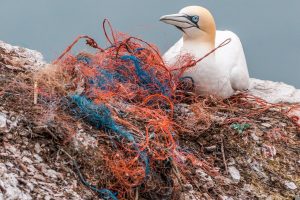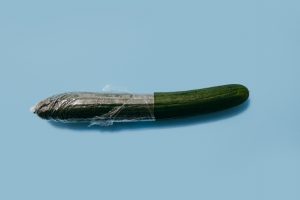 In the last 12-18 months the devastating consequences of single-use plastic pollution has come to the forefront of public debate and made many of us question our shopping and lifestyle habits. Many attribute the heart breaking scenes of plastic packaging found in marine organisms presented by Sir David Attenborough in Blue Planet 2 to the launch of this new ‘plastic-free’ movement. What was once only a campaign for eco-warriors and environmentalists has become mainstream, with #plasticfree and #zerowaste trending highly on social media.
In the last 12-18 months the devastating consequences of single-use plastic pollution has come to the forefront of public debate and made many of us question our shopping and lifestyle habits. Many attribute the heart breaking scenes of plastic packaging found in marine organisms presented by Sir David Attenborough in Blue Planet 2 to the launch of this new ‘plastic-free’ movement. What was once only a campaign for eco-warriors and environmentalists has become mainstream, with #plasticfree and #zerowaste trending highly on social media.
 The fundamental issue with plastic waste is that it does not decompose back into natural organic matter over time. Plastic, a substance originally designed to last forever, is now commonly used in disposable everyday items. The problem is that it still lasts forever, long after its ‘useful life’ is complete. The untold consequences of micro plastics entering the food chain via marine organisms, toxic fumes from burning plastic waste damaging human health and mounds of plastic rubbish destroying the environment are undeniably worrying, but as those who have attempted to live a ‘plastic free’ life know all too well, things aren’t as simple as just ‘banning plastic’.
The fundamental issue with plastic waste is that it does not decompose back into natural organic matter over time. Plastic, a substance originally designed to last forever, is now commonly used in disposable everyday items. The problem is that it still lasts forever, long after its ‘useful life’ is complete. The untold consequences of micro plastics entering the food chain via marine organisms, toxic fumes from burning plastic waste damaging human health and mounds of plastic rubbish destroying the environment are undeniably worrying, but as those who have attempted to live a ‘plastic free’ life know all too well, things aren’t as simple as just ‘banning plastic’.
Much of the debate, thus far, has been one-sided. There are so many questions out there left unanswered or even unasked. We present some of the debates around food packaging- plastic and alternative options- showing that, unless as a society, we all move to change the way we shop and our expectations, there is no ‘quick fix’.
Ditch the packaging altogether!
 The ultimate opposite to single use plastic packaging would be to sell food and other items unwrapped, but how realistic is this? It would certainly require a fundamental change in the way we do our weekly shop, but since the majority of us are now in the habit of bringing a bag with us to the supermarket (something almost unthinkable 10 years ago) it is not outside the realms of possibility that we all routinely pack Tupperware boxes, empty glass jars and other storage items when going to get groceries in the future. The success of ‘Zero Waste’ stores in recent times illustrates this point.
The ultimate opposite to single use plastic packaging would be to sell food and other items unwrapped, but how realistic is this? It would certainly require a fundamental change in the way we do our weekly shop, but since the majority of us are now in the habit of bringing a bag with us to the supermarket (something almost unthinkable 10 years ago) it is not outside the realms of possibility that we all routinely pack Tupperware boxes, empty glass jars and other storage items when going to get groceries in the future. The success of ‘Zero Waste’ stores in recent times illustrates this point.
But if everything is to be sold unwrapped then we may have to compromise on shelf life and product quality or face sharp increases in food waste. We are all used to buying a pint of milk and it lasting (if unopened in the fridge) for over a week, a packet of crisps being still ‘crisp’ after a couple of months in the cupboard, but neither of these would be viable if sold unwrapped. Then there is the problem of contamination- from the relatively trivial issue of strong flavours and smells mingling to food safety such as keeping uncooked meats and fish separate. Not only this but food containing common allergens (nuts, gluten, lactose etc) when unpackaged could pose a lethal threat to severe allergy sufferers.
 The humble shrink-wrapped cucumber is often quoted as an example of the balancing act between food waste, carbon pollution (in terms of air miles) and plastic pollution. Preventing or minimising food wastage on products with high carbon footprints is invaluable. Like ‘wonky veg’ are we all prepared to buy and pay the same for slightly ‘damaged’ unwrapped food as their perfect plastic-wrapped counterparts? Who should foot the bill for an unwrapped product being damaged in transit to the super market or in a shop? Is it the producer, the retailer or the customer? What happens currently and what are the levels of food waste in ‘Zero waste’ stores across the UK? Can we learn from their business models?
The humble shrink-wrapped cucumber is often quoted as an example of the balancing act between food waste, carbon pollution (in terms of air miles) and plastic pollution. Preventing or minimising food wastage on products with high carbon footprints is invaluable. Like ‘wonky veg’ are we all prepared to buy and pay the same for slightly ‘damaged’ unwrapped food as their perfect plastic-wrapped counterparts? Who should foot the bill for an unwrapped product being damaged in transit to the super market or in a shop? Is it the producer, the retailer or the customer? What happens currently and what are the levels of food waste in ‘Zero waste’ stores across the UK? Can we learn from their business models?
Paper wrappers?
For those products which can’t be sold unwrapped, would paper packaging be appropriate? In many cases paper can provide a partial barrier to flavour/smell/allergen contamination between products but obviously it is not a viable packaging option for ‘wet’ or oily foods. Grease-proof papers are available but the majority of these are coated with a thin layer of synthetic plastic, thus rendering them non-biodegradable.
Compostable ‘plastics’?
A natural alternative to synthetic plastic, which is compostable and breaks down into harmless organic matter with time seems like an optimal solution to the single-use plastic ‘problem’. There are a number of different bioplastics on the market, each made from plant-based materials and degradable to differing extents: some are only designed to decompose under industrial composting conditions, whereas others claim they be put in the food recycling bin for local council collection. The myriad of different compositions and standards leads to confusion, misinformation and is generally not helpful to the general public when trying to make an informed choice. Not only this, but the inherent compostabillity of bioplastics means they are not a perfect like-for-like replacement to synthetics: the size and shape of containers made out of bioplastics is severely limited, it degrades in contact with moisture and is often weaker (thereby increasing the risk of packaging breakages and food wastage).
As well as universal consensus on the definition of ‘compostability’ and international standards to govern bioplastics, there are some difficult questions that should be asked before they are employ widely, else we may end up solving one problem to be faced with another:
– Bioplastics may be renewable, but it is right to commit large areas of agricultural land to grow plants whose sole use is to make biofilms? Does the use of land, water, fertilizer and energy involved in this task outweigh the negative impact of plastic pollution?
– The inherent compostable nature of bioplastics means that they decompose after use, releasing CO2 and methane into the atmosphere. Methane is a more potent greenhouse gas than the CO2 adsorbed by growing the plants initially.
What’s stopping us recycling all our single use plastic?
When considering all the facts it is possible to conclude that the main drawback of synthetic plastic (that it doesn’t degrade with time) is also its main advantage and the reason why it is used ubiquitously in packaging. Therefore, if we are to prevent waste plastic ending up in landfill and the oceans we need to improve plastic recycling. Currently there are 7 plastic classifications in the UK – each with differing chemical compositions and properties. Sorting all of our waste into 7 different ‘pots’ (or 6 plus an ‘everything else’ category) is uneconomic, energy intensive and pretty much impossible, and that is before even considering packaging with mixed material components.
The way forward…
…has to be a combined approach, with each of us making our own contribution.
1. Where possible we can all opt for reduced plastic products – consumer power is a great market influencer!
2. It would be great if government narrowed the composition of plastics used to make our throw-away packaging to just two or three and banned the use of mixed/unrecyclable components. This would make closing the ‘plastic cycle’ much more viable.
3. International standards for plant-based bioplastics is essential if we are to understand what is meant by ‘compostability’.
4. Persuading big industry to use their financial resources to innovate research into more ‘earth friendly’ packaging options.
5. And, as highlighted in the recent War on Plastic, improved product labelling is key: to tell us what does and does not contain plastic (and hence de-mystifying hidden plastics), how to recycle it, and prevent bioplastics from contaminating synthetic plastic recycling streams.
Have you given your #OURPLASTICFEEDBACK yet?
Louise Wright
